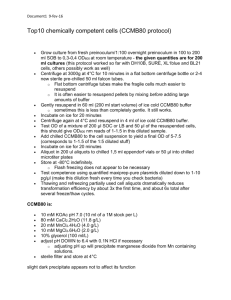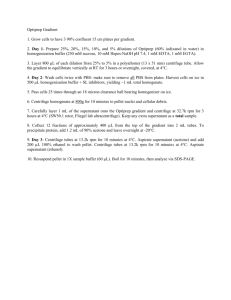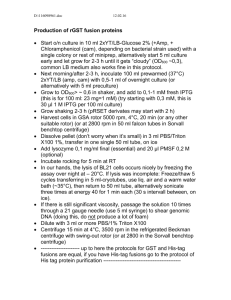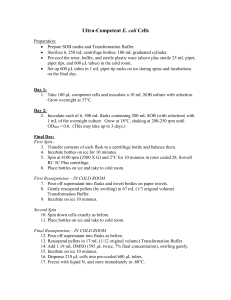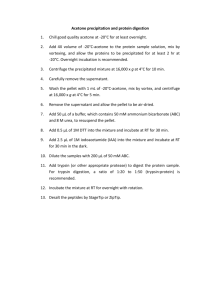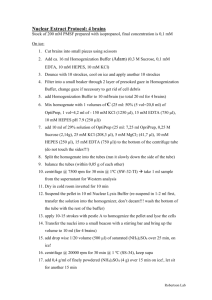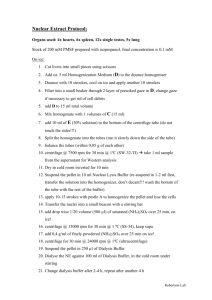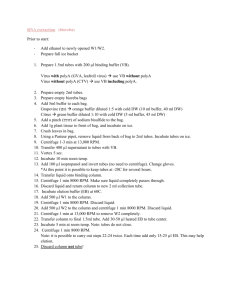Hot Borate RNA Extraction From Cotton Tissue
advertisement
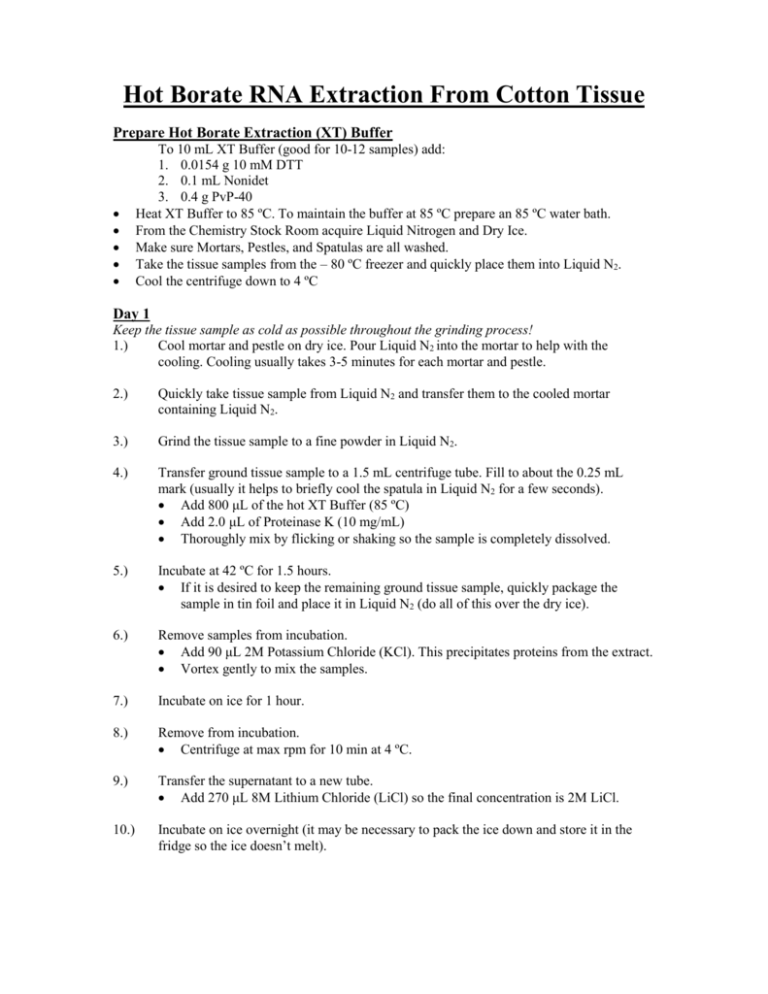
Hot Borate RNA Extraction From Cotton Tissue Prepare Hot Borate Extraction (XT) Buffer To 10 mL XT Buffer (good for 10-12 samples) add: 1. 0.0154 g 10 mM DTT 2. 0.1 mL Nonidet 3. 0.4 g PvP-40 Heat XT Buffer to 85 ºC. To maintain the buffer at 85 ºC prepare an 85 ºC water bath. From the Chemistry Stock Room acquire Liquid Nitrogen and Dry Ice. Make sure Mortars, Pestles, and Spatulas are all washed. Take the tissue samples from the – 80 ºC freezer and quickly place them into Liquid N2. Cool the centrifuge down to 4 ºC Day 1 Keep the tissue sample as cold as possible throughout the grinding process! 1.) Cool mortar and pestle on dry ice. Pour Liquid N2 into the mortar to help with the cooling. Cooling usually takes 3-5 minutes for each mortar and pestle. 2.) Quickly take tissue sample from Liquid N2 and transfer them to the cooled mortar containing Liquid N2. 3.) Grind the tissue sample to a fine powder in Liquid N2. 4.) Transfer ground tissue sample to a 1.5 mL centrifuge tube. Fill to about the 0.25 mL mark (usually it helps to briefly cool the spatula in Liquid N2 for a few seconds). Add 800 μL of the hot XT Buffer (85 ºC) Add 2.0 μL of Proteinase K (10 mg/mL) Thoroughly mix by flicking or shaking so the sample is completely dissolved. 5.) Incubate at 42 ºC for 1.5 hours. If it is desired to keep the remaining ground tissue sample, quickly package the sample in tin foil and place it in Liquid N2 (do all of this over the dry ice). 6.) Remove samples from incubation. Add 90 μL 2M Potassium Chloride (KCl). This precipitates proteins from the extract. Vortex gently to mix the samples. 7.) Incubate on ice for 1 hour. 8.) Remove from incubation. Centrifuge at max rpm for 10 min at 4 ºC. 9.) Transfer the supernatant to a new tube. Add 270 μL 8M Lithium Chloride (LiCl) so the final concentration is 2M LiCl. 10.) Incubate on ice overnight (it may be necessary to pack the ice down and store it in the fridge so the ice doesn’t melt). Day 2 Cool the centrifuge down to 4 ºC. 1.) Remove samples from ice. Centrifuge at max rpm for 10 min at 4 ºC Discard the supernatant. 2.) Wash pellet in 500 μL of ice-cold 2M Lithium Chloride (LiCl). Make sure the pellet is dispersed in the solution to minimize the retention of unwanted substances. Centrifuge at max rpm for 3 min at 4 ºC. Discard the supernatant 3.) Repeat step 2 twice more. 4.) Suspend pellet in 250 μL of 1X TE Buffer (pH 8.0) and gently vortex. Sample may be warmed to room temperature in a heating block for 5 min to facilitate diffusion. Centrifuge at max rpm for 5 min at 4 ºC to remove the insoluble material. 5.) Save the supernatant by transferring to new centrifuge tubes. Add 1/10 volume (about 25 μL) of Potassium Acetate (KAc) pH 5.5. Incubate on ice for 15 min. This will remove positively charged polysaccharides, residual proteins, and other salt-insoluble material. 6.) Remove samples from ice. Centrifuge at max RPM for 8 min at 4 ºC. 7.) Transfer supernatant to new centrifuge tubes and discard the pellet. Add 1/10 volume (about 25 μL) of 2M Sodium Acetate (NaAc) pH6.0. Add 2.5 x volumes (about 800 μL) of cold 100% ethanol. 8.) Store RNA samples at – 80 ºC. Reagents and Solutions Hot Borate Extraction Buffer (XT Buffer) For 100 mL 0.2 M Borax (Sodium-borate decahydrate) 30 mM EGTA 1% (w/v) SDS 1% sodium deoxycholic acid (deoxycholate, sodium salt) 7.63 grams 1.14 grams 1.00 gram 1.00 gram Liquid nitrogen Dry ice Proteinase K (10 mg/mL in DEPC-treated dd-water; store stock at -20 ºC) 1X TE (10 mM Tris-Hcl, pH 7.5 with 1 mM EDTA, pH 8.0) 2 M Potassium chloride (KCl) 2 M Potassium acetate (KAc), pH 5.5 2 M Lithium chloride (LiCl, keep in refrigerator) 8 M Lithium chloride (LiCl, keep in refrigerator) 3 M Sodium acetate (NaAc), pH 6.0 Ethanol, 70% and 100% (keep at -20 ºC) (Protocol updated 13 August, 2007 by Michael Salmans)

